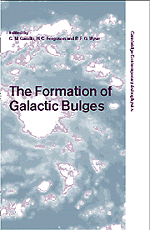Book contents
- Frontmatter
- Contents
- Preface
- Dedication: In Memory of Olin Eggen
- Part 1 Introduction
- Part 2 The Epoch of Bulge Formation
- Part 3 The Timescales of Bulge Formation
- Part 4 Physical Processes in Bulge Formation
- Part 5 Bulge Phenomenology
- Bulge-Disk Decomposition of Spiral Galaxies in the Near-Infrared
- The Triaxial Bulge of NGC 1371
- The Bulge-Disk Orthogonal Decoupling in Galaxies: NGC 4698 and NGC 4672
- The Kinematics and the Origin of the Ionized Gas in NGC 4036
- Optically Thin Thermal Plasma in the Galactic Bulge
- X-Ray Properties of Bulges
- The Host Galaxies of Radio-Loud AGN
- The Centers of Radio-Loud Early-Type Galaxies with HST
- Central UV Spikes in Two Galactic Spheroids
- Part 6 Conference Summary
- Index
The Triaxial Bulge of NGC 1371
from Part 5 - Bulge Phenomenology
Published online by Cambridge University Press: 10 November 2010
- Frontmatter
- Contents
- Preface
- Dedication: In Memory of Olin Eggen
- Part 1 Introduction
- Part 2 The Epoch of Bulge Formation
- Part 3 The Timescales of Bulge Formation
- Part 4 Physical Processes in Bulge Formation
- Part 5 Bulge Phenomenology
- Bulge-Disk Decomposition of Spiral Galaxies in the Near-Infrared
- The Triaxial Bulge of NGC 1371
- The Bulge-Disk Orthogonal Decoupling in Galaxies: NGC 4698 and NGC 4672
- The Kinematics and the Origin of the Ionized Gas in NGC 4036
- Optically Thin Thermal Plasma in the Galactic Bulge
- X-Ray Properties of Bulges
- The Host Galaxies of Radio-Loud AGN
- The Centers of Radio-Loud Early-Type Galaxies with HST
- Central UV Spikes in Two Galactic Spheroids
- Part 6 Conference Summary
- Index
Summary
We present here an optical and near-infrared (NIR) photometric study of the bulge of NGC 1371, an Sa galaxy in the Fornax cluster. The galaxy hosts a nuclear bar, from which two spiral arms depart, and a triaxial bulge and it is the most peculiar object in a sample of 17 isolated spiral galaxies studied here. The triaxial shape and the bar are apparent also in the H band, i.e. where the emission from the old (t > 107 yr) stellar population peaks (Grauer & Rieke, 1998). The implications of our findings for bulge formation and bar secular evolution models are discussed.
Introduction
Bulge morphology has often been compared to that of elliptical galaxies, both of which were initially thought to be axisymmetric. Later it was discovered that elliptical galaxies are triaxial (see for instance de Zeeuw 1989; Bender 1988; and references therein) and soon afterward also triaxial bulges in spiral galaxies were found (Kormendy 1982; Zaritsky & Lo 1986; Bertola 1989, 1991; Shaw 1993; Varela et al. 1996). The radial surface brightness profile of a triaxial bulge usually follows a classic r¼ law and the distribution of triaxial bulges in barred and unbarred galaxies is similar (Pompei 1998), so in principle triaxiality and barred potentials are unrelated. It should be noted however that earlytype galaxies host the strongest bars, which are currently supposed to have formed a long (t > 108 yr) time ago (Noguchi 1996).
- Type
- Chapter
- Information
- The Formation of Galactic Bulges , pp. 161 - 164Publisher: Cambridge University PressPrint publication year: 2000



